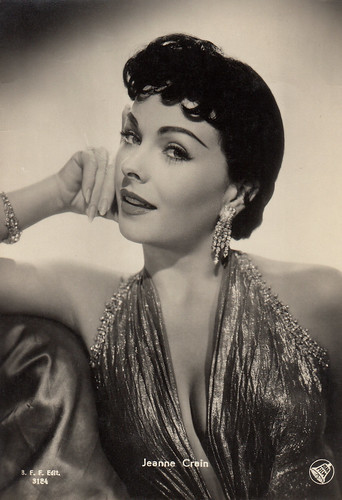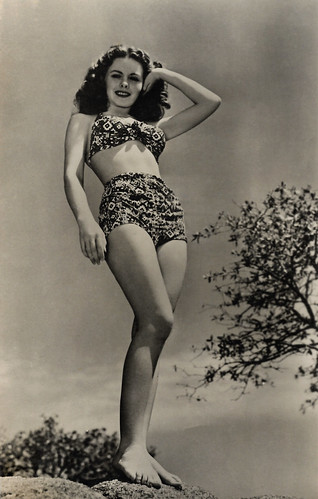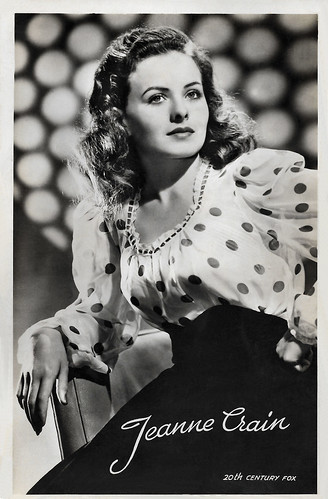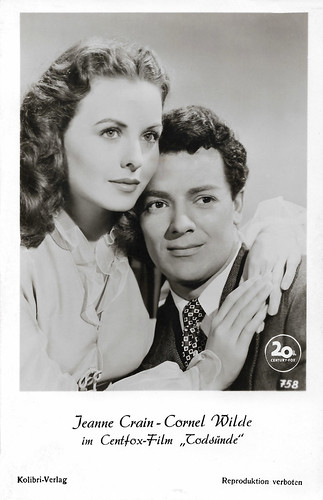
Italian postcard by B.F.F. Edit., no. 3184. Photo: Dear Film / Metro Goldwyn Mayer. Publicity still for Gentlemen Marry Brunettes (Richard Sale, 1955). Collection: Marlene Pilaete.

Spanish postcard. no. 3088.

Dutch postcard, no. 3107. Photo: 20th Century Fox.

Dutch postcard, no. 3430. Sent by mail in 1950. Photo: 20th Century Fox. Jeanne Crain with her pet lion, Shah-Shah. Crain later gave the lion to the Los Angeles Zoo. Her surname is mistakenly written here as Craine.
Miss Camera Girl of 1942
Jeanne Elizabeth Crain was born in Barstow, California, in 1925. She was the daughter of George A. Crain, a high school English teacher and his wife, Loretta Carr. Not long after her birth, Jeanne was moved to Los Angeles, where her father got another teaching position. Her parents divorced in 1934. While in junior high school, Jeanne played the lead in a school production which set her on the path to acting.
In high school, Jeanne was asked to take a screen test for the role of Lucy Morgan in The Magnificent Ambersons (Orson Welles, 1941). Unfortunately, she didn't get the part, but it did set her sights on being a film actress. After high school, Jeanne enrolled at UCLA to study drama. At the age of 18, she won the 'Miss Camera Girl of 1942' title in Long Beach, Florida. She got a bit part, posing in a bathing costume, in the Fox production The Gang's All Here (Busby Berkeley, 1943) starring Alice Faye, and a small contract.
Her next film saw Jeanne elevated to a more substantial part in Home in Indiana (Henry Hathaway, 1944), which was filmed in neighbouring Kentucky. The film was an unquestionable hit. On the strength of that box-office success, Jeanne was given a raise and star billing, as Maggie Preston, in her next film, In the Meantime, Darling (Otto Preminger, 1944). Unfortunately, the critics not only roasted the film but singled out Jeanne's performance in particular.
She rebounded nicely in her last film of the year, Winged Victory (George Cukor, 1944), opposite Lon McCallister. The audience loved it and the film was profitable. In 1945, Jeanne was cast in the Rogers and Hammerstein musical State Fair (Walter Lang, 1945) as Margie Frake who travels to the fair and falls in love with a reporter played by Dana Andrews. Louanne Hogan dubbed Crain's singing numbers. After that, Crain often had singing parts in films, and they were dubbed, in most cases by Hogan.
Another hit was Leave Her to Heaven (John M. Stahl, 1945), where Crain was the 'good' sister of 'bad' Gene Tierney, both in love with Cornel Wilde. Now, Crain got a bigger contract and more recognition. Later that year, she married Paul Brooks on New Year's Eve. Although her devoutly catholic mother wasn't supportive of the marriage, the union lasted until her husband's death. The marriage produced seven children. Brooks was a former RKO contract player who had briefly appeared in Those Endearing Young Charms (Lewis Allen, 1945). His real name was Paul Brinkman, and he gave up his acting career to become a highly successful businessman for an arms manufacturing company. The year 1947 was an off year for Jeanne, as she took time off to bear Brooks' first child. Although Crain, a practising Catholic, sued Brinkman for divorce in 1956, the decree never became final and they got back together again. In later years, they lived separately.

American postcard by EKC.

Vintage card.

Belgian postcard by Nieuwe Merksemsche Chocolaterie S.P.R.L., Merksem (Anvers), no. 3107. Photo: 20th Century Fox.
Fear of racial backlash
In 1949, Jeanne Crain appeared in three films, A Letter to Three Wives (Joseph L. Mankiewicz, 1949) with Linda Darnell and Ann Sothern, The Fan (Otto Preminger, 1949) opposite Madeleine Carroll and George Sanders, and Pinky (Elia Kazan, 1949) with Ethel Barrymore. It was this latter film which garnered her an Oscar nomination as Best Actress for her role as Pinky Johnson, a nurse who sets up a clinic in the Deep South. She lost to Olivia de Havilland for The Heiress (William Wyler, 1949). Pinky was controversial because it told the story of a light-skinned African American woman who passes for white in the Northern United States until she is forced to admit her roots. Although Lena Horne and other black actresses were considered, producer Darryl F. Zanuck chose to cast a white actress for fear of racial backlash.
The following year, Crain starred in the comedy Cheaper by the Dozen (Walter Lang, 1950), as the eldest daughter of Clifton Webb and Myrna Loy. Crain paired with Cary Grant in the offbeat drama People Will Talk (Joseph L. Mankiewicz, 1951). Crain was reunited with Loy for Belles on Their Toes (Henry Levin, 1952), the sequel to Cheaper by the Dozen, getting top billing this time. In 1953, Jeanne left Fox after starring in the Film Noir Vicki (Harry Horner, 1953), with Jean Peters. Denny Jackson at IMDb: "She had made 23 films for the studio that started her career, but she needed a well-deserved change. Jeanne wanted to expand her range instead of playing the girl-next-door types." She went briefly to Warner Brothers for the filming of Duel in the Jungle (George Marshall, 1954). The film was lukewarm at best.
That same year she signed a contract with Universal Studios with promises of better, high-profile roles. She went into production in the film Man Without a Star (King Vidor, 1955), starring Kirk Douglas, which was a hit with audiences and critics. After The Joker Is Wild (Charles Vidor, 1957) with Frank Sinatra and Mitzi Gaynor, Jeanne took time off for her family and appeared in a few television programs. She returned, briefly, to film in Guns of the Timberland (Robert D. Wenn, 1960) alongside Alan Ladd.
The films were sporadic after that. In Italy, she played Nefertiti in the Peplum Nefertiti, regina del Nilo/Nefertiti, Queen of the Nile (Fernando Cerchio, 1961) with Edmund Purdom and Vincent Price. In 1967, she appeared in a low-budget suspense yarn called Hot Rods to Hell (John Brahm, 1967) with Dana Andrews. Her final film was the thriller Skyjacked (John Guillermin, 1972), in which she was a passenger on a plane piloted by Charlton Heston.
In her retirement years, she and her husband spent most of their time working at two of their ranches. Jeanne died of a heart attack in Santa Barbara, California, in 2003. Her husband Paul Brooks had died two months earlier. Their son Paul Brinkman Jr. became a television executive, who is most known for his work on the television series JAG. Crain's youngest child, son Christopher Brinkman, was the original lead guitarist for the rock group Jane's Addiction (1985-1986). He died of a drug overdose in 1997.

West German postcard by Kolibri-Verlag, no. 758. Photo: 20th Century Fox. Jeanne Crain and Cornel Wilde in Leave Her to Heaven (John M. Stahl, 1945).

French postcard by Editions du Globe, no. 502. Photo: Metro-Goldwyn-Mayer.

French postcard by Editions du Globe, no. 503. Photo: Metro Goldwyn Mayer. Publicity still for Gentlemen Marry Brunettes (Richard Sale, 1955).

Spanish postcard, no. 2885. Photo: Metro Goldwyn Mayer. Publicity still for Gentlemen Marry Brunettes (Richard Sale, 1955). A present by Marlene Pilaete. Thanks! And please, search for the differences with the postcard at the top of this post!
Sources: Denny Jackson (IMDb), Ronald Bergan (The Guardian), Wikipedia and IMDb.
This post was last updated on 5 November 2023.
No comments:
Post a Comment